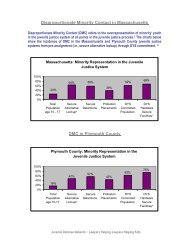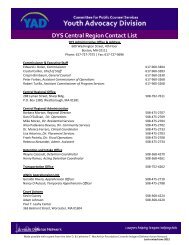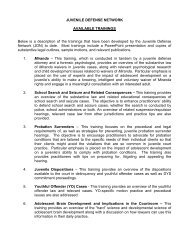States rethink 'adult time for adult crime' - the Youth Advocacy Division
States rethink 'adult time for adult crime' - the Youth Advocacy Division
States rethink 'adult time for adult crime' - the Youth Advocacy Division
You also want an ePaper? Increase the reach of your titles
YUMPU automatically turns print PDFs into web optimized ePapers that Google loves.
New research shows stark differences in teen brains<br />
New research shows stark differences in teen<br />
brains<br />
Lee Bowman, Scripps Howard<br />
Advanced search |<br />
Search tips<br />
Written by: Lee Bowman, Scripps Howard<br />
May 11, 2004:<br />
Scripps Howard News Service<br />
New research shows stark differences in teen brains<br />
By Lee Bowman<br />
Recent popular films depicting teenagers suddenly housed in <strong>adult</strong> bodies have more<br />
than a little truth in <strong>the</strong>m.<br />
The latest brain research has found strong evidence that when it comes to maturity,<br />
organization and control, key parts of <strong>the</strong> brain related to emotions, judgment and<br />
"thinking ahead" are <strong>the</strong> last to arrive.<br />
"It seems that regulation of impulse control is <strong>the</strong> last on board and often <strong>the</strong> first to<br />
leave in <strong>the</strong> brain as we age," said Dr. Ruben Gur, a professor of psychology and<br />
director of <strong>the</strong> Brain Behavior Laboratory at <strong>the</strong> University of Pennsylvania who has<br />
been researching brain development in young <strong>adult</strong>s.<br />
Until recently, most brain experts thought <strong>the</strong> human command center stopped<br />
growing at around 18 months, and that neurons were pretty much set <strong>for</strong> life by age<br />
3.<br />
In fact, <strong>the</strong> brain's gray matter has a final growth spurt around <strong>the</strong> ages of 11 to 13<br />
in <strong>the</strong> frontal lobes of <strong>the</strong> brain, <strong>the</strong> regions that guide human intellect and planning.<br />
But it seems to take most of <strong>the</strong> teen years <strong>for</strong> youngsters to link <strong>the</strong>se new cells to<br />
<strong>the</strong> rest of <strong>the</strong>ir brains and solidify <strong>the</strong> millions of connections that allow <strong>the</strong>m to<br />
think and behave like <strong>adult</strong>s.<br />
At <strong>the</strong> same <strong>time</strong>, <strong>the</strong> release of a cascade of adolescent hormones during and after<br />
puberty causes o<strong>the</strong>r areas of <strong>the</strong> brain, particularly <strong>the</strong> amygdala, which governs<br />
basic emotional response, to fire up or expand.<br />
The result is that teens look at things differently than <strong>adult</strong>s. This has tremendous<br />
implications <strong>for</strong> education, mental health, drug abuse and moral and legal<br />
responsibility of adolescents.<br />
Deborah Yurgelun-Todd of Harvard Medical School and McClean Hospital in Boston<br />
has studied how teenagers and <strong>adult</strong>s respond differently to <strong>the</strong> same images.<br />
file:///L|/JDN/Brain%20Resources/Brain%20Development/...0shows%20stark%20differences%20in%20teen%20brains.htm (1 of 4)8/16/2006 4:42:07 PM
















